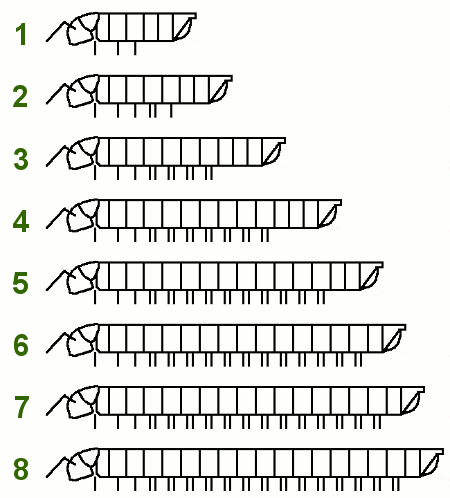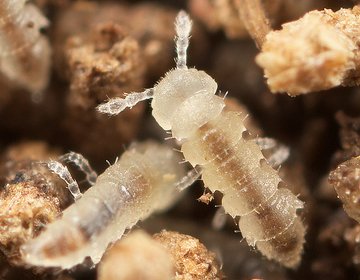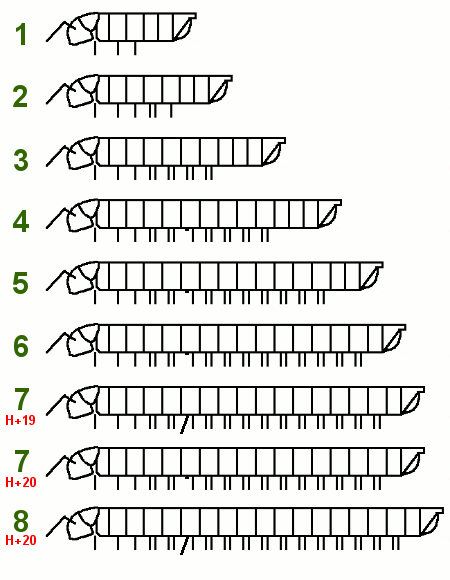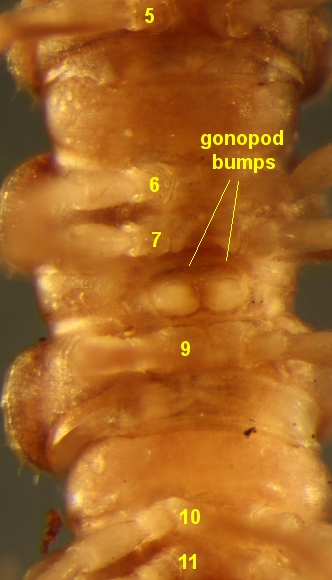Back to: body plans
Forward to: size
Growth in females
Polydesmida don't hatch out of their eggs with H+20 and H+19 body plans ready-built. Like all arthropods, millipedes can only grow by shedding their hard exoskeleton and replacing it with a new, larger one. Polydesmida do this in a very regular way. At each moult they add rings and legs at the hind end, and you can age a polydesmidan just by counting legs.
 |
H+20 Polydesmida have 8 mobile life stages, called stadia. These are shown in the drawings to the left, but please note: these drawings are not to the same scale. In reality, stadium 1 might be only one-tenth the body diameter of stadium 8, and one-tenth the length (see image below). (And as on the body plans page, I only show the legs on one side of the body.) |
Last-stadium, sexually mature individuals are called adults. Juveniles in the stadium just before the final moult are sometimes called subadults.
Summary for females:
Stadium 1: 3 single legpairs = 6 legs
Stadium 2: 4 single legpairs + 1 double legpair = 12 legs
Stadium 3: 3 single legpairs + 4 double legpairs = 22 legs
Stadium 4: 3 single legpairs + 7 double legpairs = 34 legs
Stadium 5: 3 single legpairs + 10 double legpairs = 46 legs
Stadium 6: 3 single legpairs + 12 double legpairs = 54 legs
Stadium 7: 3 single legpairs + 13 double legpairs = 58 legs
Stadium 8: 3 single legpairs + 14 double legpairs = 62 legs

Stadium 1 polydesmidans, probably a Polydesmus species (Polydesmidae), UK
Image © 2011 by Jonathan Michaelson; used with permission
Growth in males
The gonopods of male polydesmidans appear suddenly, fully formed, after the last moult (into adulthood). However, you can recognise a male from stadium 4 onwards, because the first pair of legs on ring 7 (legpair 8) is replaced by a pair of small bumps (see image below, right). These bumps are sometimes called gonopod primordia by specialists.
The growth chart for males looks like this:
 |
 |
In H+19 species, the gonopods appear suddenly in stadium 7, but the low bumps replacing legpair 8 first appear in stadium 4, just as in H+20 species.
Summary for males:
Stadium 1: 3 single legpairs = 6 legs
Stadium 2: 4 single legpairs + 1 double legpair = 12 legs
Stadium 3: 3 single legpairs + 4 double legpairs = 22 legs
Stadium 4: 3 single legpairs + '7' double legpairs (bumps replace legpair 8) = 32 legs
Stadium 5: 3 single legpairs + '10' double legpairs (bumps replace legpair 8) = 44 legs
Stadium 6: 3 single legpairs + '12' double legpairs (bumps replace legpair 8) = 52 legs
Stadium 7: 3 single legpairs + '13' double legpairs (gonopods replace legpair 8) = 56 legs (H+19 species)
Stadium 7: 3 single legpairs + '13' double legpairs (bumps replace legpair 8) = 56 legs (H+20 species)
Stadium 8: 3 single legpairs + '14' double legpairs (gonopods replace legpair 8) = 60 legs (H+20 species)
The image below shows a male (arrow points to missing legpair 8), but is it adult or juvenile?

Unidentified species of Paradoxosomatidae, New South Wales, Australia
Image © 2008 by John Schilling; used with permission
There are 14 double legpairs if we ignore those missing legs on ring 7, so this must be an H+20 adult in stadium 8. If there were only 13 double legpairs, it would be a stadium 7 male, and it could be either a juvenile H+20 or an adult H+19. To find out which, we would have to turn the millipede over and look on the underside for gonopods (H+19) or bumps (H+20).
Back to: body plans
Forward to: size
